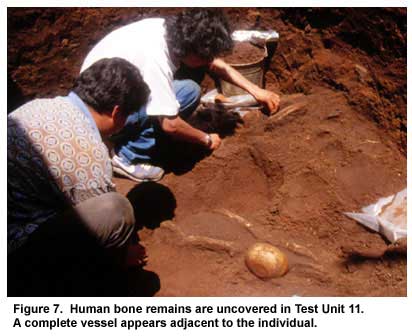
| FAMSI © 2005: Ann Cyphers |
||
Laguna de los Cerros: Test Unit 11 Test Unit 11 is particularly interesting, as it was placed adjacent to Trench 14 excavated by Medellín (1960) in Mound 51, whose ceramics were analyzed by Bove (1978). Based on this analysis, Bove suggests that the site was a primary Olmec site. The evidence he uses includes not only monuments but also ceramic types and figurines that resemble those of the San Lorenzo phase, together with the architectural arrangement and orientation. He emphasizes the presence of ceramics from this phase in levels 7 to 10 from Trench 14. With this test unit and others excavated by Medellín, it is inferred that beneath the visible architecture underlies an architectural pattern similar to that of La Venta.
Test Unit 11, excavated in 1997, was placed adjacent to Trench 14 in Mound 51, with the purpose of documenting the stratigraphic column of the building and obtaining the associated archaeological material. This test unit (Figure 6) allows to observe the presence of three higher horizons (I, II, and II/A) on top of the four refill layers (A, B, C, and D) that conform the mound. In the refill layers, ceramics typical of the Terminal Classic period such as Campamento Fine Orange, Yual Fine Cream, and Zapote Fine Grey were recovered, in addition to materials from earlier phases. Inside the mound, human burials were excavated (related to features R6, R7, and R9) (Figures 7 and 8), and vessels from the Classic period placed there as offerings were uncovered (Figure 9).
The construction of this mound and the placement of interments probably took place simultaneously, as it would seem that earth was piled up on top of the individuals instead of having placed them in a grave. The stratum underlying the refills (IV) may have been the original ground surface that served as basement or initial point for the construction. Neither Test Unit 11 nor any other one excavated between 1997 and 1998 yielded any evidence in support of the temporal assignment of construction activities in Laguna de los Cerros’ architecture, during the Preclassic period. On the contrary, it shows that the construction activity carried out during the Terminal Classic period could be completed thanks to the refills, obtained probably in areas with an earlier occupation. |
||
| Return to top of page | ||
|
Text links to all pages at this site are available at the FAMSI INDEX |
||

